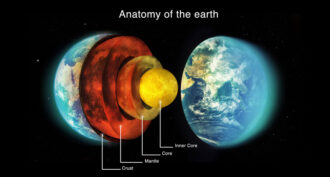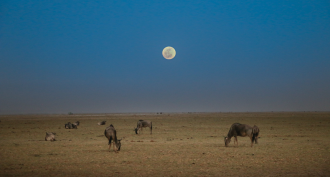Earth
-
 Earth
EarthExplainer: Earth — layer by layer
Explore the sizzling heat, unimaginable pressures — and some surprise diamonds — that sit beneath our feet. This is the side of Earth that you can’t see.
By Beth Geiger -
 Animals
AnimalsThe moon has power over animals
The moon is known for its tidal effects. But its light also can exert a powerful influence on animals large and small.
By Erin Wayman -
 Ecosystems
EcosystemsGroundwater pumping is draining rivers and streams worldwide
Excessive groundwater use could push more than half of the regions that depend on water pumped up from underground aquifers past an environmental tipping point by 2050. That could threaten aquatic ecosystems around the world.
-
 Earth
EarthEarthworms lose weight in soils polluted with microplastics
Bits of plastic pollution in the ground caused earthworms to lose weight. That could hurt the worms’ ability to make soil healthy, and may explain why plants were stunted.
-
 Earth
EarthAir pollution intensifies a teen’s feeling of stress
Living where the air is dirty may make tough situations even more stressful — especially for teens suffering from anxiety or depression.
-
 Chemistry
ChemistryCool Job: One green chemist is mining zoo dung for biological helpers
Her goal is to convert farm-field wastes into useful fuels and chemicals
-
 Oceans
OceansCool Job: This ecologist is studying an ocean of changes
A young marine ecologist is studying how warming is changing the oceans and what people can do to minimize the harm.
-
 Chemistry
Chemistry2019 Nobel Prize in chemistry goes for pioneering lithium-ion batteries
Today’s lithium-ion batteries power everything from smartphones to computers. Three scientists who pioneered those batteries just got the 2019 Nobel Prize in chemistry.
By Maria Temming and Jonathan Lambert -
 Climate
ClimateReport sums up climate’s already dramatic impact on oceans and ice
Melting glaciers, stronger storms and acidifying oceans are signs of climate change today, a new IPCC report says. Putting a brake on greenhouse emissions could limit how dire things get.
-
 Science & Society
Science & SocietyAt the United Nations, youth leaders call for true climate action
Hundreds of young climate leaders gathered on September 21 for the first-ever United Nations Youth Climate Summit.
By Greta Moran -
 Science & Society
Science & SocietyClimate misinformation may be thriving on YouTube
An analysis of 200 climate-related videos on YouTube shows that a majority challenge widely the accepted science about climate change and climate engineering.
By Sujata Gupta -
 Climate
ClimateCatch up with Climate Change Chronicles
Science News for Students spent a year documenting climate change around the globe. Here’s a roundup of the main stories from the series.